|
The 1955 Corvette looked to be just a repeat of the 1953-54 Corvette, but it was much improved in many respects. The biggest improvement was Ed Cole's superb small-block V-8, which, for an extra $135, was fitted to all but six of the '55 models sold that year; it was identified externally only by exaggerated gold "V's" overlaid on the existing "Chevrolet" name on the lower front fenders. Chevy's ads heralded it as "The V-8 that goes like a V-2," comparing the eight-cylinder Corvette to a "guided missile."
One of the many interesting innovations that made the 265 such a pivotal development was the lack of a common rocker shaft. Each rocker arm was entirely independent of the others, so that the deflection of one had no effect on the rest. Each was assembled over a valve stem and pushrod, retained by a fulcrum ball and lock nut. Regardless of whether mechanical or hydraulic lifters were used, the valves were lashed by turning the lock nut. In addition, the arrangement reduced reciprocating weight, which allowed higher rpm and cut down on raw materials.
Other features included an intake manifold that provided a common water outlet to both heads, which were die cast with integral valve guides and were completely interchangeable. A short stroke meant short connecting rods were used, which was another way to achieve higher rpm. Pressed-in piston pins eliminated the need for split rods and the required locking bolts. Five main bearings of equal diameter carried maximum loads in their lower halves.
Engine weight was saved by circulating the oil through hollow pushrods, providing splash lubrication to the rocker arms and valve stems, thus eliminating the need for separate and costly oil feeder lines. Pistons were modern slipper-type "autothermic" aluminum units with three rings; a circumferential expander for the single oil ring provided axial and radial force to control oil burning. Instead of iron, the crankshaft was forged of pressed steel because of its higher specific gravity and modulus of elasticity.
The V-8 certainly did wonders for the Corvette's performance in 1955. Though it was essentially the same engine that became newly optional in that year's passenger Chevys, the Corvette version ran a special camshaft that raised horsepower 33 above standard tune -- to a total 195 bhp at 5,000 rpm. Replacing the finicky multiple carbs was a single Rochester four-barrel version. Final-drive gearing remained at 3.55:1, but the V-8's higher rev limit prompted a revised tachometer redline of 6,500 rpm. Because the engine was lighter, fore/aft weight distribution improved, though the benefit was slight (now set at 52/48 percent).
There was no doubting the V-8's performance improvement -- it was nothing short of stunning. The benchmark 0-60-mph sprint now took just 8.5 seconds; the standing quarter-mile only 16.5 seconds. Top speed was up to nearly 120 mph. Despite this, gas mileage was actually better too. Road & Track, for example, recorded 18-22.5 mpg with Powerglide, some 2-3 mpg better than the standard six-cylinder engine.
Other changes made to accommodate the V-8 included an automatic choke for the first time since the Motorama show Corvette and a modern 12-volt electrical system, though the older six-volt setup was retained for the few six-cylinder Corvettes built that year. The previous vacuum-operated wiper motor gave way to an electric unit, and a foot-operated windshield washer returned. Tires changed from tube-type to the tubeless variety in both white- and blackwall versions.
For a time, Powerglide remained the only transmission. But later in the model run, about 75 cars were built with Corvette's first manual gearbox. This was a new close-ratio three-speed manual, which shifted via a stubby chrome stalk rising from the side of the transmission tunnel, capped by a small white ball and surrounded by a boot that was clamped to the floor by a bright metal ring showing the shift pattern. Final drive was shortened to 3.7:1, which combined with the lighter gearbox and that potent V-8 to make this the fastest Corvette yet.
As in 1953-54, the Corvette received several running changes during 1955 production. Soon after start-up, the Pennant Blue color option was replaced by Harvest Gold, with contrasting green trim and a dark green top, which became a popular combination. Metallic Copper also became available, and Sportsman Red was replaced by Gypsy Red. The latter came with white vinyl interior, red saddle stitching, and tan carpeting and top. What's more, the '55s had smoother bodies constructed of slightly thinner sections than the 1953-54 models. Fit and-finish was tidier and tighter. Early '55s retained holes in the frame rails for mounting the six-cylinder engine, but these were soon plugged once it was realized they'd probably never be used again. In addition, the X-brace on the underside of the hood was replaced by a lateral brace to clear the V-8's air cleaner.
On balance, 1955 marked a great leap forward for Corvette engineering, but not even genuine high performance, improved workmanship, and fine-tuned details could turn around the car's failing fortunes, at least not immediately. Sales actually declined to only 700 units for the model year. Chevy was still wrestling with problems that kept productions form being either efficient or significant, and the market was still dubious and elusive. Despite 1955's vast improvements, the overall package still wasn't completely "right."
|
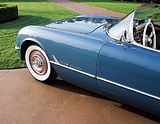
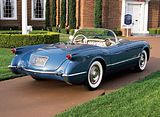
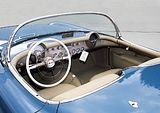
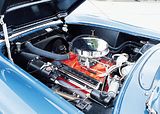
With 265 cubic inches and 195 bhp, the 1955 Corvette's V-8 trimmed the 0-60 sprint to well under nine seconds.
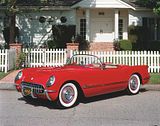
The 1955 Corvette offered a color option of Gypsy Red, which replaced the Sportsman's Red of previous models.
|
1955 Corvette Specifications
Nearly all the 1955 Corvettes packed Chevy's brilliant new small-block V-8, signaled by an exaggerated "V" in the bodyside namescript. A newly optional three-speed manual transmission also helped make that year's Corvette a much more exciting performer. Here are the specifications for the 1955 Corvette:
Vehicle Specifications
|
Convertible |
| Wheelbase, inches |
102.0 |
Length, inches
|
167.0 |
Width, inches
|
72.2 |
Track, inches
|
front: 57.0 rear: 59.0 |
Height, inches
|
51.3 |
Curb Weight, pounds
|
2,910 |
Mechanical Specifications (2-door convertible)
Suspension
front:Independent; upper and lower A-arms, coil springs, antiroll bar, tubular hydraulic shock absorbers
rear: Live axle on semi-elliptic leaf springs, tubular hydraulic shock absorbers
Wheels/Tires
6.70x15
Brakes
front: 11-inch drum
rear: 11-inch drum
Transmission
3-speed manual (std)
2-speed Powerglide (opt)
Standard axle ratio
3.55:1
Engine Specifications
| Type |
ohv I-6 |
ohv V-8 |
| Displacement, liters/cu inch |
3.85/235.5
|
4.34/265.0 |
| Bore x stroke, inches |
3.56 x 3.95 |
3.75 x 3.00 |
| Fuel Management |
3 Carter sidedraft
|
Carter 4-bbl. |
| Horsepower @ rpm |
150 @ 4200 |
195 @ 5000 |
| Torque @ rpm, pound-foot |
223 @ 2400 |
260 @ 3000 |
Published Performance Numbers
Acceleration
|
195 hp, Powerglide |
0-60 mph, sec
|
8.7 |
0-100 mph, sec
|
24.7 |
1/4-mile, sec
|
16.5 |
(Source: Road & Track)
Vehicle Production and Base Prices
Car Type
|
Production
|
Price
|
2-door convertible, six-cylinder
|
700*
|
$2,774.00 |
2-door convertible, V-8
|
|
2,909.00 |
*700 combined production
Options and Production
Option
|
Production
|
Price |
Directional Signal
|
700
|
$16.75 |
| Heater |
700
|
91.40 |
| AM Radio, signal seeking |
700
|
145.15 |
| Whitewall Tires, 6.70 x 15 |
700
|
26.90 |
| Powerglide Automatic Transmission |
625
|
178.35 |
| Parking Brake Alarm |
700
|
5.65 |
| Courtesy Lights |
700
|
4.05 |
| Windshield Washer |
700
|
11.85 |
Color Choices and Production
Color Choice
|
Production |
Color Choice
|
Production |
Polo White
|
325
|
Pennant Blue
|
45 |
Corvette Copper
|
15
|
Gypsy Red
|
180 |
Harvest Gold
|
120
|
|
|
|
|